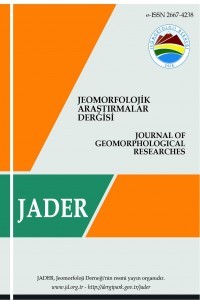UNESCO Jeoparkları ve Jeomorfoloji
Beşerî faaliyetlere bağlı olarak ortaya çıkan küresel iklim değişikliği, türlerin yok oluşu, tabii kaynakların tükenmesi gibi küresel felaket emareleri insanoğlunun yerküre farkındalığını artırmıştır. Öyle ki yakın geçmişe kadar doğa koruma ile sadece canlı varlıklar akla gelirken, artık fiziki çevrenin de korunması gerekliliği ortaya çıkmıştır. Jeopark felsefesine göre Yerkürenin tarihi en az insanlık tarihi kadar önemlidir. Jeoloji ve jeomorfolojinin diliyle yazılan bu kadim bilgiler yerkürenin işleyişini ve gelecekteki değişimlerini anlamak bakımından hayati öneme sahiptir. Doğa ve kültür mirası tarihinde son üç yüz yıldır kabaca her asırda yeni bir kavramın doğduğu görülür. 21. Yüzyılın doğa koruma ve alan yönetimi paradigması olan jeoparklar 2000 yılında dört Avrupa ülkesinin öncülüğünde (Yunanistan, Almanya, İspanya, Fransa) kurulan Avrupa Jeoparklar Ağı ile vücut bulmuştur. Jeoparkların üç temel hedefi vardır: Yer mirasının etkin biçimde korunması, doğa eğitimleri ile toplumun yerküre farkındalığını artırma ve jeoturizm vasıtasıyla sosyo-ekonomik yerel kalkınma sağlama. Avrupa’da doğan jeopark kavramı kısa sürede küresel ölçekte kabul görmüş ve 2015 yılında UNESCO IGGP programına dahil edilerek uluslararası nitelik kazanmıştır. Jeopark statüsü; doğa koruma ve alan yönetimi konusuna, jeosit, jeomorfosit, jeoturizm, jeoçeşitlilik gibi yeni yaklaşımlar ve terimler kazandırmıştır. “Jeosit - Jeomorfosit” terimi, yerkürenin geçmişini anlamak bakımından öneme sahip yüzey şekilleri ve yapılar olarak tanımlanmaktadır. Biyoçeşitlilik teriminden adapte edilen “Jeoçeşitlilik” terimi ise fiziki yüzeyi meydana getiren her türlü jeolojik ve jeomorfolojik oluşumu ifade eder. Jeoturizm, jeoparklarla doğan yeni bir doğa turizmi çeşididir. Dünya genelinde jeoparkların yoğunlaştığı sahalara bakıldığında jeoparkların bir kalkınmışlık göstergesi olduğu görülür. Jeolojik ve jeomorfolojik oluşumlar bakımından oldukça zengin olan ülkemizde sadece Kula Jeoparkı UNESCO tarafından tescillenmiştir. Türkiye’nin jeolojik ve jeomorfolojik mirasının hak ettiği bilimsel itibara ve sürdürülebilir ekonomik kalkınmaya kazandırılmasında coğrafyacılara büyük görev düşmektedir.
Anahtar Kelimeler:
Jeopark, Jeomorfoloji, Jeosit, Jeoturizm, Jeoçeşitlilik, UNESCO
UNESCO Geoparks and Geomorphology
Human awareness on our Planet Earth has risen due to natural disasters such as global warming, extinction of species, depletion of natural resources as a result of anthropogenic activities. Until recently, nature protection meant only conservation of natural biota, where nowadays the protection of the physical environment becomes a necessity. According to the geopark philosophy, the history of the Planet Earth is no less important than the history of us. The history of natural and cultural monuments has witnessed a new concept every single century for the last 3 hundred years. geopark is the new nature protection and site management paradigm of the millennium. The Geopark concept came up existence in 2000 with the establishment of the European geoparks Network by four European countries (Greece, Germany, France, Spain). Geoparks have three aims: effective conservation of earth heritage, raising public awareness on Planet Earth via geoeducation and creating sustainable socio-economic local development based on Geotourism. Geopark ide was born in Europe and gained global recognition in 2015 under the UNESCO IGGP program. Geoparks brought new concepts and terms to nature protection and site management area such as geosite, geomorphosite, geotourism and geodiversity. Geosites and geomorphosites are natural structures and topographies which are important for understanding the history of the Planet Earth. Geodiversity term was adapted from Biodiversity refers to the richness of any kind of lithological and topographical variation. Geotourism is a new nature tourism organized within geoparks. Global distribution and density pattern of geoparks can be used as an indirect development scale for nations. Although Turkey hosts a rich geodiversity, only Kula Geopark managed to become a UNESCO Geopark. Consequently, Geographers holds a great responsibility for the international scientific recognition and utilization of Turkeys geopark potential as a sustainable local development tool.
Keywords:
Geopark, Geomorphology, Geosite, Geotourism, Geodiversity, UNESCO,
___
- Bunburry, J. M. R. (1992) The Basalts of Kula. PhD Thesis, Cambridge University [(unpublished]
- Dowling, R. K. ve Newsome, D. (2006) Geotorusim. Elsevier Butterworth-Heinemann Publication.
- Eder, W. F. Patzak, M. (2001) Geological Heritage of UNESCO. European Geoparks Network magazine No:1
- Ercan, T. (1981) Kula Yöresinin Jeolojisi ve Volkanitlerin Petrolojisi [Geology of Kula region and pertology of volcanics]. PhD Thesis, İstanbul University [unpublished, in Turkish with English abstract]
- Erinç, S. (1970) The young volcanic topography of the Kula-Adala area. İstanbul Üniversitesi Coğrafya Enstitüsü Dergisi 17, 7–22Gray, M. (200). Geodiversity: valuing and conserving abiotic nature. John Wiley, Chichester, 434pp
- Gümüş, E. (2008) Yeni bir doğa koruma kavramı: UNESCO Jeoparklar çerçevesinde Çamlıdere (Ankara) Fosil ormanı fizibilite çalışması. Ondokuz Mayıs Üniversitesi Sosyal Bilimler Enstitüsü Coğrafya Anabilim Dalı. [Yayınlanmamış Master Tezi]
- Gumus, E. (2014) Geoparks: multidisciplinary tools for the protection and management of geoheritage in Turkey. Kula volcanic area (Manisa) and Çamlıdere fossil forest (Ankara) as case studies. Aegean University of Greece, School of Social Sciences, [Unpublished Doctorate Thesis]
- Panizza, M. (2001) Geomorphosites: concepts, meth ods and example of geomorphological survey. In: Chinese Science Bulletin 46, Suppl. vol.: 4-6
- Reynard, E. ve Panizza, M. (2005) Geomorphosites: definition, assessment and mapping. An introduction. – In: Géomorphologie. Relief, processus, environnement 3: 177-180
- Şen, E. Aydar, E. Bayhan, H. Gourgaud, A. (2010) Physical volcanology of Kula Volcanic Field, western Anatoli. İTÜ Avrasya Yer Bilimleri EnstitüsüZouros, N. (2005) Assessment, protection and promotion of geomorphological and geological sites in the Aegean area, Greece. Géomorphologie: relief, processus, environnement, no 3, 227-234
- Zouros, N. (2007) Geomorphosite assessment and management in protected areas of Greece. Case study of the Lesvos island-coastal geomorphosites. Geographica Helvetica, 62(3), 169
- Yayın Aralığı: Yılda 2 Sayı
- Başlangıç: 2018
- Yayıncı: Jeomorfoloji Derneği
